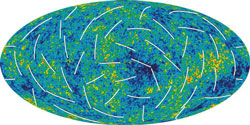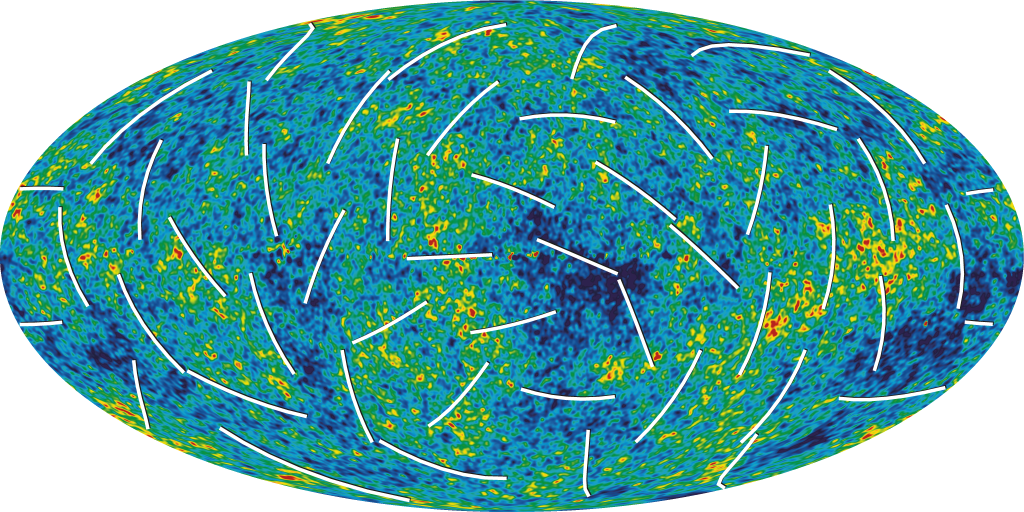Testing a Universal Symmetry
The laws of physics show many symmetries. No matter what direction you toss a ball, for example, its interactions with Earth’s gravity follow the same rules. But theorists looking for ways to connect quantum theory with relativity have suggested that a fundamental symmetry known as CPT might be violated, even though it underlies all of modern physics. In the 9 June PRL, researchers describe a new way to test this basic principle using measurements of the microwave glow leftover from the big bang. Their analysis shows a small CPT violation, although it is statistically consistent with no violation. Still, experts say the paper shows a new way to test fundamental symmetries, and it will continue to be useful as better data become available.
All known interactions in particle physics heed a rule known as CPT invariance. Start with a collection of interacting particles, then create a mirror-image version (parity reversal, P), change the signs on all electrical charges ( C), and let time run backward ( T). Under CPT invariance, the interactions among the particles in these two complementary situations–before and after the CPT reversals–are identical, as are the probabilities for each possible outcome. Because CPT involves space and time operations, it turns out that any violation of CPT invariance would disrupt the spacetime symmetries embodied in relativity theory.
In effect, CPT violation would mean that not all directions in space are equivalent. There would be one special direction in space, and electromagnetic radiation would propagate differently depending on its orientation relative to this special direction. To look for this effect, Bo Feng of the National Astronomical Observatories in Beijing and his colleagues scrutinized recent measurements of the cosmic microwave background or CMB–radiation filling the universe that arose from the big bang.
Data from the satellite-borne Wilkinson Microwave Anisotropy Probe (WMAP) and the BOOMERANG instrument, flown by balloon over Antarctica, include detailed measurements across the sky of the direction of the electric field, or polarization, of the CMB. If CPT symmetry is violated, then all polarizations will rotate with respect to the special space direction as the radiation travels through the universe.
Although we can’t follow a single CMB photon to see if its polarization changes over time, Feng and his colleagues realized that polarization rotation would generate a relationship among CMB polarizations measured at different points on the sky. That is, polarization at two points would not be randomly related but would have a specific type of correlation with each other. They found signs of this correlation in their analysis, but statistically speaking, it could have arisen from random chance.
Even if further measurements were to confirm the correlation, Feng is quick to admit, it would not be a definitive demonstration of CPT violation. His team’s test, strictly speaking, detects a P violation in the way photons propagate. However, there is no P-violating theory for photons that doesn’t also violate CPT, says Feng. Moreover, CPT violation of this type may have a natural connection to the “dark energy” that cosmologists have recently postulated to explain novel features of cosmic expansion.
Marc Kamionkowski of the California Institute of Technology in Pasadena says that until recently, looking for exotic phenomena such as CPT violation was mostly regarded as “a fishing expedition–a waste of time.” But since nobody has any clue what dark energy is, he adds, previously unthinkable hypotheses have gained some credibility. Though their results are as yet inconclusive, the Chinese team has performed “a nice measurement,” he says, and their efforts should prompt further scrutiny of the available data.
–David Lindley
David Lindley is a freelance science writer, now retired. His most recent book is The Dream Universe: How Fundamental Physics Lost Its Way (Penguin Random House, 2020).
More Information
Another recent test for a preferred reference frame in the Universe: B. R. Heckel et al., “New CP-Violation and Preferred-Frame Tests with Polarized Electrons,” Phys. Rev. Lett. 97, 021603 (2006)





